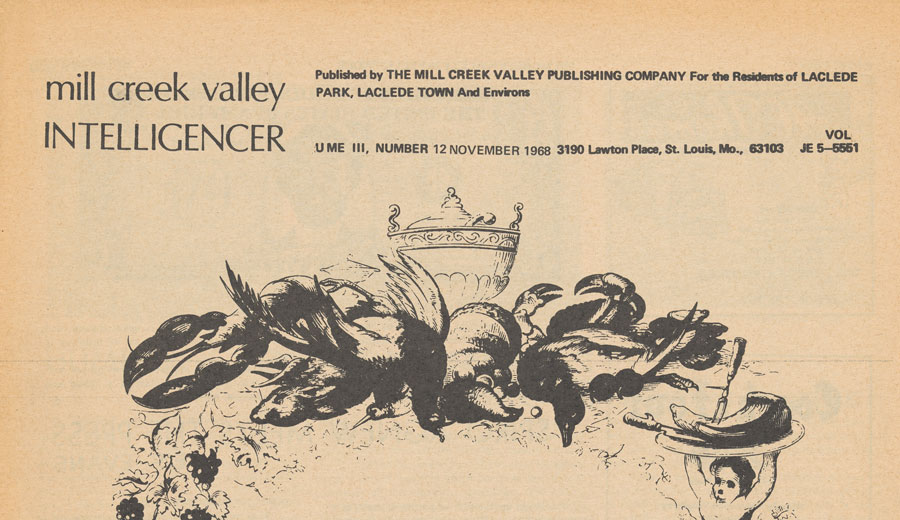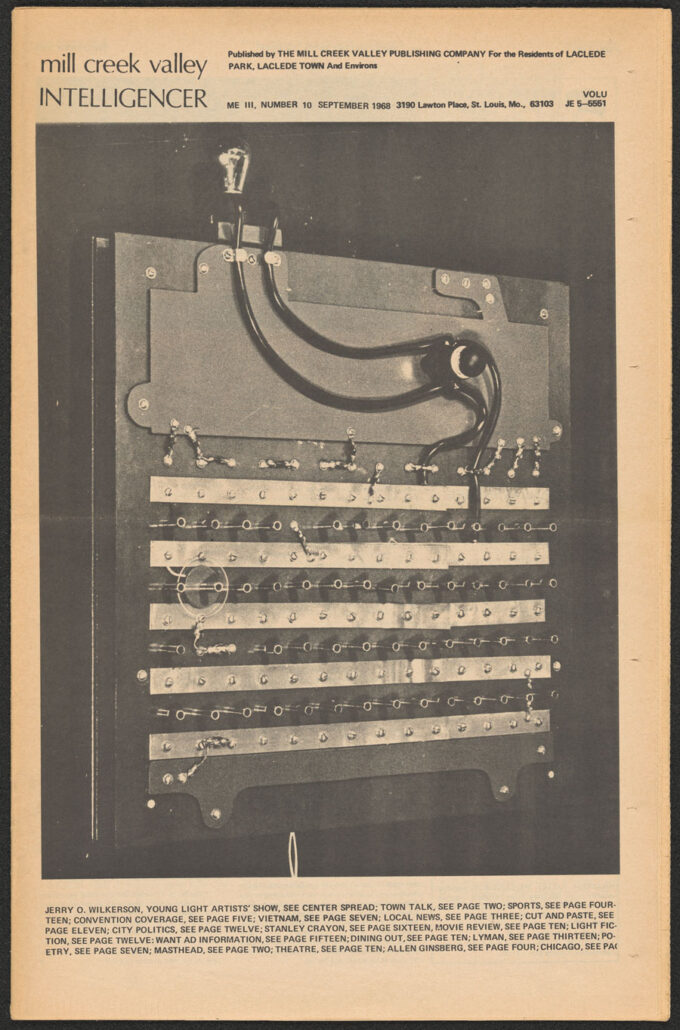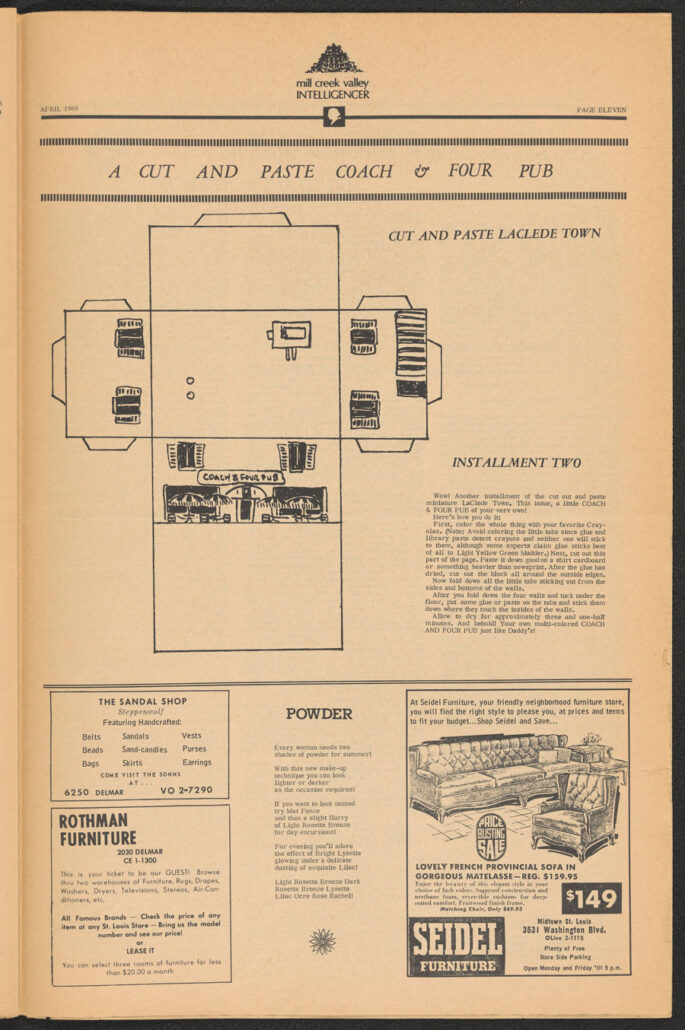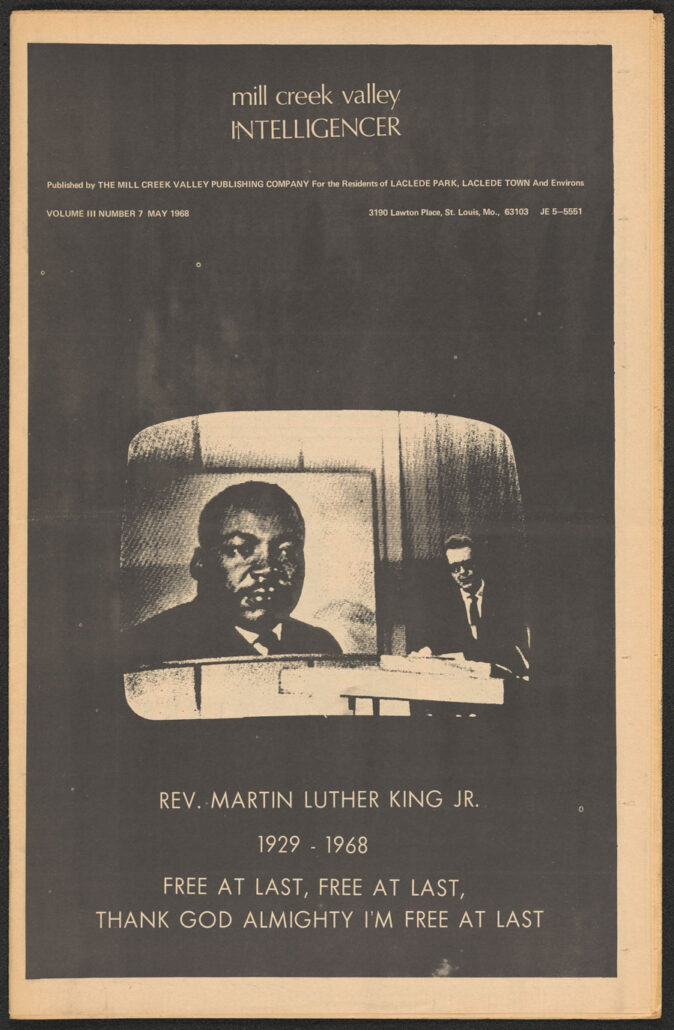20,000 residents, 43 churches, over 800 businesses. A thriving Black community, demolished. Now, the pieces are being put back together.
A few weeks ago, Anderson Archival met with Christopher Gordon and Levi Cullifer of the Missouri Historical Society.
Gordon, Director of Library and Collections, has been with the Society for 23 years. He is responsible for the archives, the library, conservation, collections, management and registration. Cullifer, Digitization Cataloging Specialist for the Library and Photos and Prints Department, oversees digitization and digital access as well as cataloging. He started at the Society as a research assistant almost 5 years ago.
We chatted about the organization in general and about a very special collection and upcoming exhibit.
AA: To kick us off, could you share some basic information about the Missouri Historical Society? Are there current exhibits or projects you’d want to highlight for our readers?
Christopher Gordon (CG): The Missouri Historical Society was founded in 1866. It’s an umbrella organization for the Missouri History Museum, but it also operates two other entities, Soldiers Memorial Military Museum, which is in downtown Saint Louis, and the Missouri History Historical Society’s Library and Research Center on Skinker.
Since 1866, we’ve been collecting documents, photographs, objects, and later on, sound and moving images. We have one of the premier collections across the board in the United States.
Our strengths tend to be, of course, Saint Louis and the Saint Louis region, but that goes all the way back to the colonial period, French and Spanish colonial archives.
Our flagship collection is the Lewis and Clark, the Corps of Discovery. Probably the most famous items that we have in the collection are William Clark’s journals from the Corps of Discovery, including the only surviving field journal from that expedition, called the Elkskin Journal.
We also have Charles Lindbergh’s papers that include his flight logs from the 1927 Transatlantic Flight right through to about the World War Two period. It does include things like the Lindbergh kidnapping case.
We have over 400 archival collections that deal directly with the Civil War. We have 175,000 objects in the collection that cover a whole range of history in Missouri and in Saint Louis and over a million photographs and prints in the collection.
Levi Cullifer (LC): We collect a wide variety of anything from negatives to posters to glass plate negatives. One of our oldest collections came from the 1850s, the Thomas Easterly daguerreotypes, one of the earliest views of Saint Louis through photography we have housed here. We have huge collections such as the Edward Goldberger Studio Collection and the Sievers Studio Collection. Each one has easily over 10,000 images. Quite a bit more probably.
We just finished cataloging and digitizing Sievers Panorama Collection, which included over 3,600 unique panoramas of the city, its groups and neighboring areas. It is a very large collection that is being made publicly available.
CG: All our collections feed into our exhibits. We’ve had two large exhibits that opened this year. In April, the latest iteration of the World’s Fair exhibit opened and then over the summer we had Collected opening, which is an incredible exhibit of standalone artifacts from our collection.
These are artifacts that either have not been on exhibit for many, many years or have never been on exhibit. Items that are new to the collection or items that have been around for a very long time. It’s just a wonderful collection to see.
In November we have Mill Creek Valley opening, which is a history of the neighborhood that [is] now lost, Mill Creek. It documents the incredible story of this sadly defunct, or now disappeared, neighborhood that was the heart of the African American community in in Saint Louis.
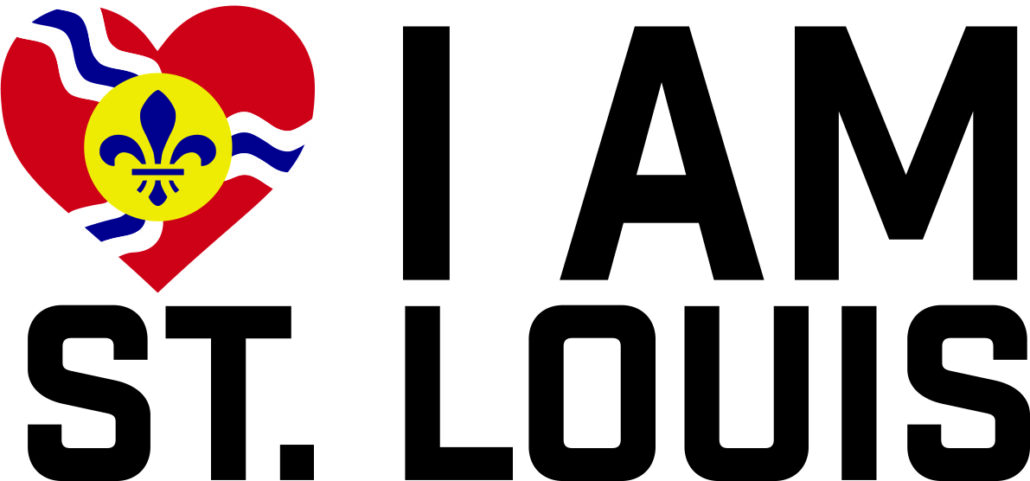
AA: I’d love to learn a bit about the We Are St. Louis project featured on the Society’s website.
CG: We Are Saint Louis is an effort to show how history and the present interact and to teach people about Saint Louis in ways that they might not have known about in the past.
Saint Louis was the capital of Louisiana Purchase territory, certainly in the early years. It was a city, a town or a frontier town, however you want to categorize it, on the edge of civilization. Everything flowed in and out of Saint Louis. This continued into the early 20th century. There were so many amazing discoveries, amazing social events that happened in Saint Louis.
The We Are Saint Louis campaign focuses on educating people about this amazing past but also allowing people to put that in perspective and understand the present. Where we came from, but also how we can capitalize on that to make our community even stronger today.
AA: As someone who also works with a lot of collections, I know it is hard to pick out a favorite. That said, do you have a favorite exhibit or collection that you’ve worked on?
CG: I started out as an archivist here. One of the collections that I was grateful to work on, we have had this collection since the 1930s, was the de La Sue collection. It covers the de La Sue family. Charles de La Sue was the last Spanish Lieutenant governor of Upper Louisiana during the final years of the French and colonial period. He was the person that signed over the Louisiana Purchase territory in this part of the territory to the United States during the Four Flags ceremony.
The collection consists of his family papers that go all the way back to the 1540s. It’s his papers, it’s his father’s papers, and then subsequent generation, his sons as well. It is incredible content, not only talking about day-to-day life in French colonial Saint Louis, his interactions with the Native Americans and so forth, but it includes also his own personal bound handwritten copy of the Louisiana Purchase.
Some of the documents are signed by the kings of France. Henry the 4th’s signature in there, but also Louis the 15th, which was signed just a year or so before the French Revolution.
LC: I technically have two favorites, one for each department. For Photos and Prints it would be the Sievers Panoramic collection. I cataloged every single one of the 3,600 panoramas. It was just a wonder to see everything that he shot, the variety that he shot.
The studio’s motto was, “I’ll shoot anything.”
He really did go far and wide for this. We believe that he was one of the few panorama photographers in the region because he was being pulled into different communities and different areas, brought out to far reaching towns in Missouri and Illinois, and he shot everything from Hoovervilles on the Saint Louis levee to military parades in Mill Creek Valley.
When we were going through that collection, that Mill Creek Valley photo, we believe it’s one of the earliest photographs taken in Mill Creek.
In the Library it would be the menu collection. We have a very large menu collection.
It’s roughly around 1,600 menus and it’s so interesting to see the variety of food that Saint Louis has had within its history. We have menus going back to the 1850s all the way up to 2024.
AA: What can you tell our readers about the Mill Creek Valley collection, and efforts to digitize materials related to it?
LC: [The digitization project] was privately funded through the Smithsonian Museum of African American History. Last year they would go from city to city with two components. One component was more community based. They had a digitization mobile and they would drive around digitizing family collections. The other part was working with institutions within the area that had collected on the African American experience.
We’re one of the largest museums in the region that has a collection to that extent. We were partnering with them on that. And then situations changed, and we are not sure what exactly happened. We don’t know what occurred behind the scenes because we weren’t really told.
We have also been affected by other grants being cut.
CG: The grant that we lost was not a collections access grant. It was a building capacity grant. It was a storage expansion grant. We have yet to complete a five-year renovation. We were fortunate that the NEH (National Endowment for the Humanities) grant that we received allowed us to kick it off, but now it’s gone. So we’ve had to privately fund the remainder.
LC: We’ve also unfortunately lost, like many other institutions, IMLS (Institute of Museum and Library Services). Myself and another person were funded through IMLS for our first year.
MHS made the commitment that they wouldn’t furlough us because the grant being cut. We’ve been switched over to another private funding source.
AA: If folks want to help support the Missouri Historical Society, how should they do that?
CG: You mentioned the We Are Saint Louis campaign. That is bundled into our capital campaign which continues to raise money for our storage expansion.
We also have a variety of opportunities for individuals to fund conservation needs. They can go on our website and see actual individual artifacts, and objects, and archival material. They can take on those projects if they want, almost like an adopt an artifact type of situation.
LC: We’ve been very successful with that so far. The Library has had five items fully funded for conservation. I can only speak to the Library portion, but it has been successful. We have a large base of items that could use love and support.
AA: We’ve touched a little bit on Mill Creek Valley. What is in that collection? For the exhibit coming out in November, what can people anticipate seeing?
LC: When the Smithsonian came to us with this project, we all went to our individual areas to find collections that hit on Mill Creek or hit on the African American experience, specifically in preparation for the Mill Creek Black Metropolis exhibit.
Each department had a wide variety of items. Library had a lot of printed reports about when urban renewal was moving forward, plus many newspapers, which we’ll talk about in a minute, the Mill Creek Valley Intelligencer and the Argus.
Archives houses a lot of oral history transcripts. Prints has the Limelight Newspaper and Irving Williamson collection. Those are both newspaper-based photography collections that span from the 1960s all the way up to the early 2010s.
Media had primarily home films and audio, including oral histories from various community members that grew up in Mill Creek or during that time period of urban renewal.
AA: What made the Intelligencer a top pick for digitization?
LC: The Intelligencer is a newspaper that came directly out of the area. It was based in Laclede Town, which was an area that many displaced people from Mill Creek went to.
Its primary focus, kind of like the Argus, was community-based but with national interests within the black community. It was a community piece that brought people together.
We don’t have very many newspapers from Mill Creek or Mill Creek area. The only other one is the Argus, which was printed in Mill Creek specifically. We have a few issues of the Mirror, but there’s a very small amount.
The Intelligencer is a large collection that spanned the late 50s, late 60s. It was at least 10 years removed from urban renewal. But it does hit on a lot of the issues of the day.
It was very important for us to get digitized, specifically since newspaper, as you probably know, does not last very long. It likes to break down a lot quicker, so those are a higher priority for us.
Now that they’re shot, they can be put in archival housing, which they already were, and not be touched unless for certain reasons.
AA: What are your thoughts on working with Anderson Archival on digitizng the Intelligencer?
CG: First of all, I’d like to thank Anderson Archival for the incredible job that you did. The quality of the scans are incredible. Levi can speak to it more than I can, but we were all impressed with the work. We really were.
LC: I’m in agreement, the image quality was superb, including the OCR files that came along with them. That is something that we’re striving towards and you guys made it a lot easier for us to work with that.
I loved being able to do the tour of the facility. It’s a great location, especially for securing our artifacts, which is our main priority for us.
We can’t wait to have them online. They should be online this week. I had already done the metadata portion and you guys were able to do everything else. It really streamlined the process.
I’m hoping in the future there is funding that comes around because we do have a lot of other projects, newspaper projects, that we would like to try and get forward.
We have something called No Bad News that it’s one of the early gay newspapers in the area and we have the best collection of it in the United States. We have one more issue than the State Historical Society. It is in poor condition, so that is something that we’re going to try and fundraise for.
CG: It’s also reassuring to know that we have a resource that’s local. We’ve done outsourcing in the past where we’ve had to send it halfway across the country or sometimes all the way across the country. But to know that there’s a quality firm here that can do the work, that’s great.
AA: Maybe this blog will be the first time someone in our audience has heard about Mill Creek Valley. I think broadening that knowledge is everyone’s goal.
LC: Hopefully the story about Mill Creek can be more widely shared, especially with the upcoming exhibit in November.
Learn more about Mill Creek: Black Metropolis on the Missouri Historical Society website and don’t forget to visit the exhibit when it opens in November. If you aren’t local to St. Louis and can’t make it in person, dive into the digital Intelligencer.
Whether you are looking for a digitization and archival partner close to home in Saint Louis or need a trusted partner you’ll travel for, contact Anderson Archival today for a free consultation.


